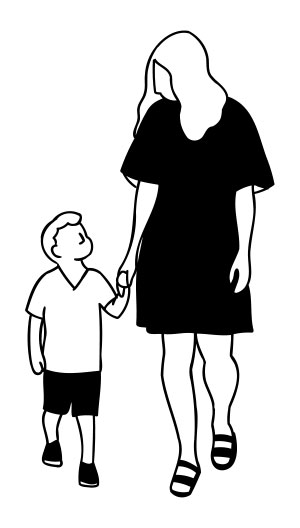Data and Methodology
This website comprises existing, available data about compensation for community organizers in New York City. There are two data sources: a compensation study conducted by Nonprofit NY in 2024 and individual job announcements posted since the start of 2024 (“new jobs data”). With survey data from 381 different organizations, the Nonprofit NY study provides a bird’s eye view of who works at nonprofits in New York City. It speaks to the breakdown of subsectors within the nonprofit universe (as defined by the National Taxonomy of Exempt Entities used by the IRS), organizations’ budget size, employee demographics, and compensation and benefits.
The vast majority of positions considered as organizers are listed in “Human Services” and at organizations with a budget between $1,000,000 and $4,999,999. In general, the number of respondents in other subsectors who employ organizers is too small to glean comparative data across different types of employers.
New jobs data was pulled through postings on Google, idealist.org, and LinkedIn. The data includes 33 open positions, with nearly all containing the word “organizer” in the title or mirroring the jobs included in the Nonprofit NY data. The data excludes positions that were part-time or did not require one to live in the New York metro area, as well as electoral campaign or union organizer jobs. There was a wide range of employers, including housing organizations, local government, and base-building groups working at both the citywide and neighborhood levels.
In the data available across both sources, the most meaningful comparative relationships fall between two categories: a lower tier of community, senior, or digital organizers, and an upper tier consisting of managers and directors. Thus, this website uses a two-tiered system for job level, the lower being non-managerial and upper being managerial. The lower tier jobs are presumed to be classified as non-exempt and eligible for collective bargaining.
Overall, the two data sources yield very similar estimates for average compensation. Final estimates were set against the cost of living calculations by Economic Policy Institute for three different family structures (one adult with no children, two adults with no children, and one adult with one child) living in eight counties in the New York metropolitan area: the five boroughs of New York City, Westchester County, Nassau County, and Hudson County, NJ.
While the cost of living in New York City is notoriously expensive, this data shows how difficult it can be for residents to make ends meet even without any dependents, and how truly impossible it is for those who have them.
This website includes broad data and also focuses on positions with descriptions that align with All Due Respect’s definition of community organizers:

“Recruits potential members through canvassing, 1-1s, trainings, events, and/or meetings to build and grow a base rooted in a site, region, issue, or identity. Supports the leadership development of members and facilitates the process of members building relationships, identifying and analyzing issues that impact them, and taking action together.”
Key Numbers and Takeaways
A. Nonprofit NY 2024 Compensation Study
Overview
- 41% of respondents (146/381) have a budget between $1,000,000–$4,999,999.
- 39.4% of respondents (150/381) have
roles categorized as “Human Services.” (Organizational categories determined by IRS NTEE codes, definitions of Human Services orgs found here under “P”.) - Respondents on average employ 67 full-time employees and 28 part-time employees.
- Respondents on average employ 51 employees who are people of color, an average of 54% of an organization’s paid staff (FTE and PTE).
- Respondents on average employ 6 LGBTQ+ employees and 2.5 employees who are transgender, genderqueer, questioning, self-identified, or gender nonconforming.
- Respondents on average employ 27 people who identify as women.
In community organizer positions specifically, defined by the compensation study as “responsible for grassroots outreach efforts, advocacy campaigns, and recruiting and training volunteers to support the outreach efforts of the organization”:
- 18.11% (69/318) of organizations identify as having community organizers on staff.
- 57.9% (40/69) of the organizations identify as in the field of Human Services.
- 42% (29/69) of the organizations have a budget between $1,000,000–$4,999,999.
Compensation
| Job Title | N | Average |
|---|---|---|
| Community Health Worker (1) | 15 | $47,209 |
| Membership Director (2) | 16 | $112,524 |
| Membership Associate (1) | 15 | $53,161 |
| Membership Manager (2) | 21 | $72,287 |
| Volunteer Manager (2) | 31 | $70,320 |
| Volunteer Coordinator (1) | 30 | $55,888 |
| Community Organizer (1) | 69 | $63,315 |
| Organizing Director (2) | 30 | $90,496 |
| Total, All Jobs | 227 | $70,650 |
| Lower tier (1) | 129 | $54,893 |
| Upper tier (2) | 98 | $86,406 |
Benefits
Organizations with the highest proportion of community organizers also tend to have health insurance coverage and retirement plans, relative to total respondents.
Does the organization provide health insurance coverage for employees?
| Respondents | Yes | Yes % | No | No % |
|---|---|---|---|---|
| All Respondents | 326 | 85.6% | 55 | 14.4% |
| Subsector | ||||
| Arts, Culture & Humanities | 47 | 12.3% | 17 | 4.5% |
| Education | 37 | 9.7% | 7 | 1.8% |
| Environment & Animals | 21 | 5.5% | 5 | 1.3% |
| International/Foreign Affairs | 8 | 2.1% | 1 | 0.3% |
| Health | 18 | 4.7% | 2 | 0.5% |
| Human Services | 141 | 37% | 9 | 2.4% |
| Mutual/Membership Benefit | 2 | 0.5% | 0 | 0.0% |
| Public/Social Benefit | 33 | 8.7% | 8 | 2.1% |
| Religion | 1 | 0.3% | 0 | 0% |
| Other | 18 | 4.7% | 46 | 1.6% |
| Budget Size | ||||
| Under $125,000 | 3 | 0.8% | 5 | 1.3% |
| $125,000–$249,999 | 3 | 0.8% | 15 | 3.9% |
| $250,000–$499,999 | 11 | 2.9% | 17 | 4.5% |
| $500,000–$749,999 | 13 | 3.4% | 9 | 2.4% |
| $750,000–$999,999 | 17 | 4.5% | 4 | 1.0% |
| $1,000,000–$4,999,999 | 152 | 39.9% | 5 | 1.3% |
| $5,000,000–$9,999,999 | 54 | 14.2% | 0 | 0% |
| Over $10 million | 73 | 19.2% | 0 | 0% |
Does the organization have a retirement savings plan?
| Respondents | Yes | Yes % | No | No % |
|---|---|---|---|---|
| All Respondents | 300 | 78.7% | 81 | 21.3% |
| Subsector | ||||
| Arts, Culture & Humanities | 40 | 10.5% | 24 | 6.3% |
| Education | 32 | 8.4% | 12 | 3.1% |
| Environment & Animals | 20 | 5.2% | 5 | 1.6% |
| International/Foreign Affairs | 9 | 2.4% | 0 | 0% |
| Health | 18 | 4.7% | 2 | 0.5% |
| Human Services | 130 | 34.1% | 20 | 5.2% |
| Mutual/Membership Benefit | 2 | 0.5% | 0 | 0% |
| Public/Social Benefit | 30 | 7.9% | 11 | 2.9% |
| Religion | 1 | 0.3% | 0 | 0% |
| Other | 18 | 4.7% | 6 | 1.6% |
| Budget Size | ||||
| Under $125,000 | 2 | 0.5% | 6 | 1.6% |
| $125,000–$249,999 | 3 | 0.8% | 15 | 3.9% |
| $250,000–$499,999 | 9 | 2.4% | 19 | 5.0% |
| $500,000–$749,999 | 12 | 3.1% | 10 | 2.6% |
| $750,000–$999,999 | 15 | 3.9% | 6 | 1.6% |
| $1,000,000–$4,999,999 | 134 | 35.2% | 23 | 6.0% |
| $5,000,000–$9,999,999 | 53 | 13.9% | 1 | 0.3% |
| Over $10 million | 72 | 18.9% | 1 | 0.3% |
B. New Jobs Data
In November 2022, New York City instituted a law requiring pay transparency on all job postings. Research indicates that while transparency helps, it can still mask inequalities, especially regarding race and gender. The law in NYC has not been in effect long enough for its impact to be known. However, it created the opportunity to compile a small set of new jobs data from postings alone.
With more information available in job postings, more detailed—though not necessarily more meaningful—data can be pulled from this smaller data set. This includes three key sets of information: starting salary bands as opposed to the actual pay reported in the NPNY survey data (band size ranges from $2,000–$25,000, and 8 positions indicate no range).
If qualifications include a range of years of experience, the data includes the bottom end of that range. If a job description includes experience in its qualifications without providing a number of years, it was defined as 1 year. This data does not distinguish between preferred and required qualifications regarding experience or degree. Bilingual qualifications are only included if they are required.
Averages
| Overall minimum | $60,296 |
| Overall cap | $67,363 |
| Overall average | $63,829 |
| Non-managerial minimum | $55,943 |
| Non-managerial cap | $62,000 |
| Non-managerial average | $58,972 |
| Managerial minimum | $83,802 |
| Managerial cap | $91,502 |
| Managerial average | $87,652 |
| Eligible Positions (presumed) | Average Minimum | Average Maximum |
|---|---|---|
| Unionized (13) | $57,786 | $62,593.86 |
| Non-unionized (14) | $54,232 | $60,696 |
Thoughts and takeaways:
- 33% (11/33) of jobs posted are for tenant organizers.
- The only jobs that do not mention benefits are temporary contracts.
- 76% (25/33) of postings include a salary band, with the rest including a single amount.
- Jobs with union representation have slightly higher salaries.
Notes on qualifications:
- 18% (6/33) of postings mention an advanced degree, even as a preferred qualification.
- 18% (6/33) of jobs require multiple languages (excludes jobs where bilingual candidates are preferred).
- Entry level community organizer jobs still require an average of 2 years of experience. (If a posting indicates a range of years of experience, the data reflects the lower end. If a posting indicates experience desired without specifying number of years, the data indicates 1 year of experience required.)
General Results
| Nonprofit NY | New jobs data | Average | |
|---|---|---|---|
| Non-managerial | $54,893 | $58,972 | $56,933 |
| Managerial | $86,406 | $87,652 | $87,029 |
The difference between the Nonprofit NY study and new jobs data for lower tier
salaries varies slightly (<$10,000), accounting for inflation (3.4% in 2023) with a slight increase to reflect overall wage growth. Given this consistency across data sets, it is reasonable to use the inflation-adjusted average salary from both data sets to arrive at the most accurate estimates.
Comparing Compensation to Cost of Living
The following uses calculations by the Economic Policy Institute (EPI) for cost of living by county in the United States. The EPI Family Budget combines data from relevant federal government agencies, supplemented as necessary, on costs of housing, food, childcare, transportation, healthcare, and taxes. A detailed outline of the methodology for the calculator can be on the EPI website.
Table 1 shows cost of living estimates for three different household structures. A key distinction between these three categories is that a single adult is priced for a studio apartment, two adults for a one-bedroom, and one adult and one child for a two-bedroom.
Tables 2–4 show the differences between the salary averages presented above and these costs. The lower tier average salary (first row of numbers) is $56,933 and the upper tier (second row) is $87,029. In other words, the difference is how much more employers need to pay in order for organizers to afford the cost of living.
Table 1: Cost of Living
| 1 adult, 1 child (two bedroom) | 2 adults, no child (1 bedroom) | 1 adult, no child (studio) | |
|---|---|---|---|
| Kings | $105,326 | $82,281 | $67,557 |
| New York | $118,684 | $93,860 | $78,454 |
| Queens | $111,372 | $86,948 | $72,879 |
| Richmond | $109,407 | $85,271 | $70,260 |
| Bronx | $93,902 | $72,388 | $57,843 |
| Nassau | $116,986 | $87,679 | $63,854 |
| Westchester | $108,363 | $81,476 | $60,693 |
| Hudson | $81,494 | $71,659 | $60,219 |
| Overall Average | $105,692 | $82,695 | $66,470 |
Table 2 : one adult, no children
Table 2 presents data for the large numbers of young people in community organizing work, who are often single adults without dependents. Assuming these workers also hold lower-tier positions, the Bronx, Nassau, Westchester, and Hudson fall within an affordable range. Inner-ring suburbs may become affordable with salary increases, and only by reaching upper tier positions do other boroughs (Brooklyn and Staten Island) become affordable.

| Upper tier ($87,029) | Lower tier ($56,933) | |
|---|---|---|
| Kings | +$19,472 | -$10,624 |
| New York | +$8,575 | -$21,521 |
| Queens | +$14,150 | -$15,946 |
| Richmond | +$16,769 | -$13,327 |
| Bronx | +$29,186 | -$910 |
| Nassau | +$23,175 | -$6,921 |
| Westchester | +$29,336 | -$3,760 |
| Hudson | +$26,810 | -$3,286 |
| Overall Average | +$20,934 | -$9,537 |
Table 3: two adults, no children
Costs for a two-adult household are estimated using the cost of a one-bedroom apartment, indicating partners as opposed to roommates. There are clear advantages to a two-salary household. However, if one adult were to lose their job or was unable to work for any reason, table 3 shows the impossibility of a functioning one-income household even without children.

| Upper tier ($87,029) | Lower tier ($56,933) | |
|---|---|---|
| Kings | +$4,748 | -$25,348 |
| New York | -$6,831 | -$36,927 |
| Queens | +$81 | -$30,015 |
| Richmond | -$1,758 | -$28,338 |
| Bronx | +$14,641 | -$15,455 |
| Nassau | -$650 | -$30,746 |
| Westchester | +$5,553 | -$24,543 |
| Hudson | +$15,370 | -$14,726 |
| Overall Average | +$4,334 | -$25,762 |
Table 4: one adults, one child
Finally, table 4 displays the massive increase in costs of having one child, making salaries woefully inadequate at all levels. Even for jobs in the upper tier, salaries fall short of the cost of living by an average of $18,663.

| Upper tier ($87,029) | Lower tier ($56,933) | |
|---|---|---|
| Kings | -$18,297 | -$48,393 |
| New York | -$31,655 | -$61,751 |
| Queens | -$24,343 | -$54,439 |
| Richmond | -$22,378 | -$52,474 |
| Bronx | -$6,873 | -$36,969 |
| Nassau | -$29,957 | -$60,053 |
| Westchester | -$21,334 | -$51,430 |
| Hudson | +$5,535 | -$24,561 |
| Overall Average | -$18,663 | -$48,759 |

Conclusion
Currently, employers count on community organizers to live in the Bronx or outside the five boroughs without any dependents. The gap between average organizer salaries and cost of living is untenable when considering the cost of living in Manhattan. The jumps in costs across counties and as family size increases come, in large part, from housing. Given the housing affordability crisis in New York City and across the country, it follows that 1/3 of organizing jobs posted since the start of 2024 are for tenant organizers. The same affordability issues that impact many of the communities that organizers serve, which are leading long-time residents to leave the core of the city, impact organizers as well, especially when they start families.
